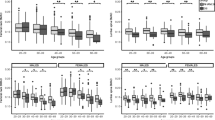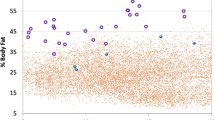Abstract
Summary
Population with Down syndrome (DS) has lower areal BMD, in association with their smaller skeletal size. However, volumetric BMD and other indices of bone microarchitecture, such as trabecular bone score (TBS) and calcaneal ultrasound (QUS), were normal.
Introduction
Patients with DS have a number of risk factors that could predispose them to osteoporosis. Several studies reported that people with DS also have lower areal bone mineral density, but differences in the skeletal size could bias the analysis.
Methods
Seventy-five patients with DS and 76 controls without intellectual disability were recruited. Controls were matched for age and sex. Bone mineral density (BMD) was measure by Dual-energy X-ray Absorptiometry (DXA), and volumetric bone mineral density (vBMD) was calculated by published formulas. Body composition was also measured by DXA. Microarchitecture was measured by TBS and QUS. Serum 25-hidroxyvitamin D (25OHD), parathyroid hormone (PTH), aminoterminal propeptide of type collagen (P1NP), and C-terminal telopeptide of type I collagen (CTX) were also determined. Physical activity was assessed by the International Physical Activity Questionnaires (IPAQ-short form). To evaluate nutritional intake, we recorded three consecutive days of food.
Results
DS individuals had lower height (151 ± 11 vs. 169 ± 9 cm). BMD was higher in the controls (lumbar spine (LS) 0.903 ± 0.124 g/cm2 in patients and 0.997 ± 0.115 g/cm2 in the controls; femoral neck (FN) 0.761 ± .126 g/cm2 and 0.838 ± 0.115 g/cm2, respectively). vBMD was similar in the DS group (LS 0.244 ± 0.124 g/cm3; FN 0.325 ± .0.073 g/cm3) and the controls (LS 0.255 ± 0.033 g/cm3; FN 0.309 ± 0.043 g/cm3). Microarchitecture measured by QUS was slightly better in DS, and TBS measures were similar in both groups. 25OHD, PTH, and CTX were similar in both groups. P1NP was higher in the DS group. Time spent on exercise was similar in both groups, but intensity was higher in the control group. Population with DS has correct nutrition.
Conclusions
Areal BMD is reduced in DS, but it seems to be related to the smaller body and skeletal size. In fact, the estimated volumetric BMD is similar in patients with DS and in control individuals. Furthermore, people with DS have normal bone microarchitecture.

Similar content being viewed by others
References
Jones KL (2006) Smith’s recognizable patterns of human malformation, 6th edn. Elsevier Saunders, Philadelphia
Sherman SL, Allen EG, Bean LH, Freeman SB (2007) Epidemiology of down syndrome. Ment Retard Dev Disabil Res Rev 13:221–227
Wiseman FK, Alford KA, Tybulewicz VL, Fisher EM (2009) Down syndrome recent progress and future prospects. Hum Mol Genet 18:75–83
Matute-Llorente Á, González-Agüero A, Gómez-Cabello A, Vicente-Rodríguez G, Casajús J (2013) Decreased levels of physical activity in adolescents with down syndrome are related with low bone mineral density: a cross-sectional study. BMC Endocr Disord 4:13–22
Real de Asua D, Quero M, Moldenhauer F, Suarez C (2015) Clinical profile and main comorbidities of Spanish adults with Down syndrome. Eur J Intern Med 26:385–391
Hawli Y, Nasrallah M, El-Hajj Fuleihan G (2009) Endocrine and musculoskeletal abnormalities in patients with Down syndrome. Nat Rev Endocrinol 5:327–334
Angelopoulou N, Souftas V, Sakadamis A, Mandroukas K (1999) Bone mineral density in adults with Down’s syndrome. Eur Radiol 9:648–651
Angelopoulou N, Matziari C, Tsimaras V, Sakadamis A, Souftas V, Mandroukas K (2000) Bone mineral density and muscle strength in young men with mental retardation (with and without Down syndrome). Calcif Tissue Int 66:176–180
Guijarro M, Valero C, Paule B, Gonzalez-Macias J, Riancho JA (2008) Bone mass in young adults with Down syndrome. J Intellect Disabil Res 52:182–189
Baptista F, Varela A, Sardinha L (2005) Bone mineral mass in males and females with and without Down syndrome. Osteoporosis Int. 16:380–388
Sakadamis A, Angelopoulou N, Matziari C, Papameletiou V, Souftas V (2002) Bone mass, gonadal function and biochemical assessment in young men with trisomy 21. Eur J Obstet Gynecol Reprod Biol 100:208–212
Sabaté J (1993) Estimación de la ingesta dietética: métodos y desafíos. Med Clin (Barc) 100:591–596
Wahner HW, Looker A, Dunn WL, Walters LC, Hauser MF, Novak C (1994) Quality control of bone densitometry in a national health survey (NHANES III) using three mobile examination centers. J Bone Miner Res 9:951–960
Katzman DK, Bachrach LK, Carter DR, Marcus R (1991) Clinical and anthropometric correlates of bone mineral acquisition in healthy adolescent girls. J Clin Endocrinol Metab 73:1332–1339
Lu PW, Cowell CT, LLoyd-Jones SA, Briody JN, Howman-Giles R (1996) Volumetric bone mineral density in normal subjects, aged 5–27 years. J Clin Endocrinol Metab 81:1586–1590
González-Agüero A, Vicente-Rodríguez G, Moreno L, Casajús J (2011) Bone mass in male and female children and adolescents with Down syndrome. Osteoporosis Int 22:2151–2157
Babaroutsi E, Magkos F, Manios Y, Sidossis LS (2005) Body mass index, calcium intake, and physical activity affect calcaneal ultrasound in healthy Greek males in an age-dependent and parameter-specific manner. J Bone Miner Metab 23:157–166
Mokhtari-Dizaji M, Dadras MR, Larijani B (2007) Influence of bone thickness on densitometric and ultrasonic parameters, an in vivo study. Pak J Biol Sci 10:545–552
McKelvey KD, Fowler TW, Akel NS, Kelsay JA, Gaddy D, Wenger GR, Suva LJ (2013) Low bone turnover and low bone density in a cohort of adults with Down syndrome. Osteoporos Int 24:1333–1338
Whitt-Glover MC, O'Neill KL, Stettler N (2006) Physical activity patterns in children with and without Down syndrome. Pediatr Rehabil 9:158–164
Izquierdo-Gomez R, Martínez-Gómez D, Acha A, Veiga OL, Villagra A, Diaz-Cueto M (2014) Objective assessment of sedentary time and physical activity throughout the week in adolescents with Down syndrome. The UP & DOWN study. Res Dev Disabil 35:482–489
Karlsson MK, Rosengren BE (2012) Training and bone—from health to injury. Scand J Med Sci Sports 22:15–23
Daly RM (2007) The effect of exercise on bone mass and structural geometry during growth. Med Sport Sci 51:33–49
Soler Marín A, Xandri Graupera JM (2011) Nutritional status of intellectual disabled persons with Down syndrome. Nutr Hosp 26:1059–1066
Luke A, Sutton M, Schoeller DA, Roizen NJJ (1996) Nutrient intake and obesity in prepubescent children with Down syndrome. Am Diet Assoc 96:1262–1267
Del Arco C, Riancho JA, Luzuriaga C, González-Macías J, Flórez J (1992) Vitamin D status in children with Down’s syndrome. J Intellect Disabil Res 36:251–257
Stagi S, Lapi E, Romano S, Bargiacchi S, Brambilla A, Giglio S, Seminara S, de Martino M (2015) Determinants of vitamin d levels in children and adolescents with down syndrome. Int J Endocrinol 2015:896758
Author information
Authors and Affiliations
Corresponding author
Ethics declarations
Conflicts of interest
None.
Rights and permissions
About this article
Cite this article
García-Hoyos, M., García-Unzueta, M.T., de Luis, D. et al. Diverging results of areal and volumetric bone mineral density in Down syndrome. Osteoporos Int 28, 965–972 (2017). https://doi.org/10.1007/s00198-016-3814-1
Received:
Accepted:
Published:
Issue Date:
DOI: https://doi.org/10.1007/s00198-016-3814-1




